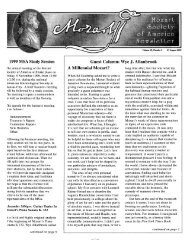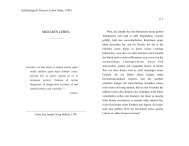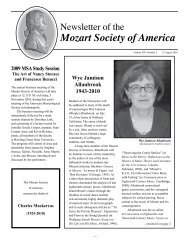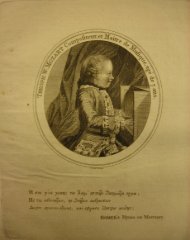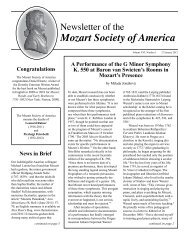January 2002 - Mozart Society of America
January 2002 - Mozart Society of America
January 2002 - Mozart Society of America
Create successful ePaper yourself
Turn your PDF publications into a flip-book with our unique Google optimized e-Paper software.
An Informal Review: Mitridate at the Santa Fe Opera, Summer 2001<br />
<strong>Mozart</strong>'s very first opera, written at the<br />
age <strong>of</strong> 14, is one that many musicians and<br />
scholars who are not serious students <strong>of</strong><br />
opera probably know little about. In my<br />
own teaching, in fact, I have always<br />
found this piece more useful for<br />
demonstrating the conventions <strong>of</strong> virtuoso<br />
opera seria emulated by its teenaged<br />
composer than for its inherent qualities as<br />
a piece <strong>of</strong> dramatic music. So when the<br />
Santa Fe Opera announced that it planned<br />
to begin staging a series <strong>of</strong> the entire<br />
corpus <strong>of</strong> <strong>Mozart</strong>'s operas, beginning with<br />
this 1770 work, I wondered how we<br />
would manage to get through the<br />
performance, much less how this opera<br />
would fare with the audience and critics.<br />
It is thus a particular pleasure to report<br />
that I found the Santa Fe production<br />
unexpectedly rewarding<br />
What we would like from a<br />
performance <strong>of</strong> an opera from another<br />
time is a chance to experience something<br />
<strong>of</strong> what contemporaneous audiences<br />
would have heard and seen and felt, but in<br />
a way that makes musical and theatrical<br />
sense to us today. These two goals<br />
sometimes seem to be in conflict, <strong>of</strong><br />
course, and productions <strong>of</strong> eighteenthcentury<br />
operas have tended (much to the<br />
dissatisfaction <strong>of</strong> many music historians)<br />
to favor the second far above the first. In<br />
the case <strong>of</strong> an ope ra seria, however, it<br />
must be admitted that some familiarity<br />
and sympathy with the conventions and<br />
expectations <strong>of</strong> the time would appear to<br />
be essential for both performers and<br />
audience if the performance is to succeed.<br />
It is hard to know how many <strong>of</strong> the<br />
operagoers who attended the handful <strong>of</strong><br />
performances at Santa Fe were in<br />
possession <strong>of</strong> that knowledge. What was<br />
most gratifying for enthusiasts <strong>of</strong><br />
eighteenth-century opera, however, was<br />
that both music and stage directors<br />
apparently trusted the opera as <strong>Mozart</strong><br />
had written it, and avoided imposing the<br />
kind <strong>of</strong> "creative" production we have<br />
come to expect in the opera house.<br />
The singers, most rather young but<br />
<strong>Mozart</strong> and the Keyboard<br />
Second Biennial Conference <strong>of</strong> the <strong>Mozart</strong> <strong>Society</strong> <strong>of</strong> <strong>America</strong><br />
Call for Papers<br />
nearly always up to the significant<br />
challenges <strong>of</strong> this music, delivered their<br />
arias for the most part in character but<br />
without extraneous movement; the sparse<br />
sets and simple costumes were (with the<br />
exception <strong>of</strong> a rather unsuccessful rising<br />
floor toward the end and a very peculiar<br />
costume for Ismene) appropriate but not<br />
intrusive. The occasional ornamentation<br />
<strong>of</strong> da capo returns was modest but tasteful<br />
As in <strong>Mozart</strong>'s mid-century serious-opera<br />
models, virtually every aria is a virtuoso<br />
showpiece, requiring skill and stamina<br />
from the singers and a certain level <strong>of</strong><br />
indulgence on the part <strong>of</strong> the audience.<br />
Yet there were two or three numbers that<br />
were seriously touching, adumbrating the<br />
dramatic sense that was to become so<br />
striking in Idomeneo. In sum, this was an<br />
unexpectedly satisfying performance <strong>of</strong><br />
an opera that turned out to be well worth<br />
seeing; I look forward with anticipation to<br />
future productions in the series.<br />
The <strong>Mozart</strong> <strong>Society</strong> <strong>of</strong> <strong>America</strong> will hold its second biennial conference at Cornell University in Ithaca,<br />
New York, on 28-30 March 2003. "<strong>Mozart</strong> and the Keyboard" will be the conference theme, with<br />
presentations, performances, and exhibitions that focus on eighteenth-century keyboard instruments and<br />
issues <strong>of</strong> repertoire, idiom, style, and performance practice. Proposals for papers on these and other aspects<br />
<strong>of</strong> <strong>Mozart</strong> and the keyboard are invited.<br />
Please send a one-page abstract (plus proposer's name and contact information) by 15 July <strong>2002</strong> to<br />
Kathryn L. Shanks Libin, Dept. <strong>of</strong> Music, Vassar College, Poughkeepsie NY 12604-0018; e-mail:<br />
kalibin@vassar.edu or ksl@nic.com.<br />
-11-<br />
-Jane R. Stevens<br />
University <strong>of</strong> California<br />
San Diego




